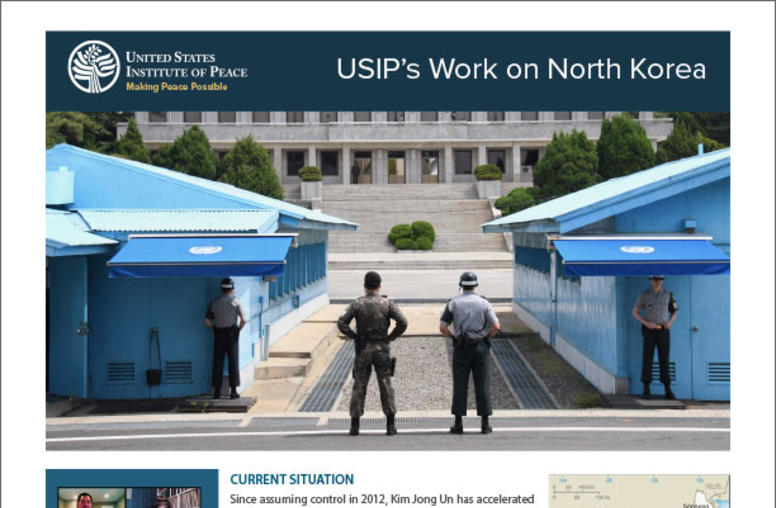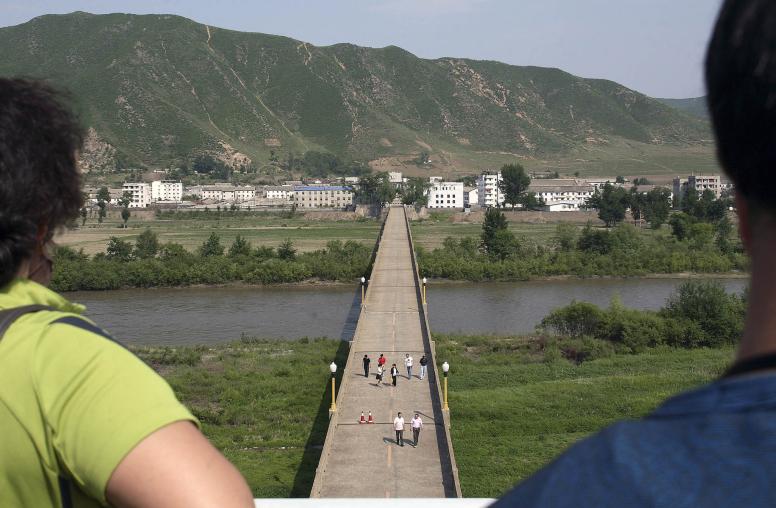Will the ‘Washington Declaration’ Deter North Korea?
The U.S. strengthens its nuclear umbrella over South Korea. But recent history shows that similar measures have led to provocations from Pyongyang.
South Korean President Yoon Suk-yeol is in Washington this week as the United States and South Korea celebrate 70 years of bilateral ties. Yoon’s visit is only the second state visit hosted by the Biden administration and the first South Korean state visit in 12 years. While there have been some recent strains in the relationship over U.S. trade and semiconductor policy and Seoul’s support for Ukraine, the focus of the bilateral summit was on the threat posed by North Korea. Although the summit ostensibly achieved both sides’ desired security deliverables related to deterrence, reassurance and nonproliferation, these outcomes will likely not provide enduring solutions to the North Korea challenge.

Last year, Pyongyang conducted more missiles tests than in any previous year. Earlier in April, North Korea launched its first solid fuel intercontinental ballistic missile, a major advance in its nuclear capabilities and officials in Washington and Seoul believe Pyongyang is preparing its first nuclear test since 2017. Against this backdrop, South Korea was seeking a more forceful reiteration of Washington’s commitment to provide extended deterrence. In previous joint presidential statements and military joint communiques, the United States has offered consistent, but rehashed, language about “using the full range of U.S. defense capabilities, including nuclear, conventional, and missile defense capabilities.”
The Yoon administration desired a more tangible demonstration of the U.S. commitment, including new U.S. strategic asset deployments to the Korean Peninsula. For its part, the United States was looking to subdue the growing calls among South Korean elites and the broader citizenry for the country to develop its own nuclear weapons program. Over the last decade, polls have consistently shown around 70% of South Koreans support indigenous nuclear weapons.
Strengthening the Nuclear Umbrella
The summit addressed these concerns. In the joint “Washington Declaration,” the United States agreed to establish a “Nuclear Consultation Group” (NCG) that would give South Korea greater insight and voice into the planning process for nuclear contingencies and use. The NCG resembles the NATO Nuclear Planning Group that Seoul hoped to emulate, though without the aspect of forward-deployed nuclear weapons.
In addition, the United States stated that it would enhance the visibility of U.S. strategic asset deployments to the Korean Peninsula, including port visits by nuclear ballistic missile submarines, which has not occurred since 1981. In return, South Korea recommitted to disavowing any intention to develop a domestic nuclear weapons program, which is already a part of its obligation as a signatory to the Nuclear Non-Proliferation Treaty. Reinforcing alliance coordination and nonproliferation commitments are important accomplishments that improve mutual security.
Will it Deter North Korea?
While the declaration may provide both sides with some benefits, it is unlikely that these deliverables will actually deter North Korea’s military demonstrations and advances or mollify the South Korean public about not having their own nuclear weapons.
Research and history show that enhanced alliance deterrence measures do not deter provocative North Korean actions and rhetoric, but tend to exacerbate them. A 2020 study by Jordan Bernhardt and Lauren Sukin demonstrated that North Korea systematically responds to U.S.-South Korea joint military exercises with aggression, and the intensity of the responses depends on the severity of the threat that the particular exercises pose. For example, between 2013-2017, when the alliance ramped up its deterrence demonstrations and joint military exercises in response to North Korea’s third nuclear test in February 2013, Pyongyang responded with the greatest advances in its nuclear weapons program, including three more nuclear tests and over 90 ballistic missile tests.
Pyongyang’s stepped-up military activity last year — which included the aforementioned record-high missile tests and the debut of an assorted array of military advances like hypersonic glide vehicles and underwater drones — was in response to the alliance’s reinvigorated military exercises and shows of force after a four-year period of de-escalation requested by the previous Moon Jae-in administration.
If the goal was, more broadly, to deter a war on the Korean Peninsula, then the question still remains whether these enhanced deterrence measures are necessary and prudent. The existing combined conventional and nuclear capabilities of the U.S.-South Korea alliance were already sufficient to deter major North Korean attacks over the last 70 years. However, a vicious cycle of military enhancements on both sides in the name of deterrence has escalated tensions and accelerated arms-racing on the Korean Peninsula and in the region. Given that North Korea’s principle for dealing with the United States is “power for power, goodwill for goodwill,” the alliance should not be surprised by a reciprocal response from North Korea, including potentially a nuclear test, a military satellite launch or a show of solidarity with China.
South Koreans’ Concerns
This summit’s outcomes also don’t provide a definitive end to the South Korean nuclear armament debate because its root causes are complicated and were not fully addressed. South Korean support for nuclear weapons capacity is not entirely based on the North Korean threat or poor confidence in the U.S. extended deterrence commitment. A 2022 study by the Chicago Council on Global Affairs and the Carnegie Endowment showed that the main driver of support for a domestic nuclear arsenal was the threat from China (55%), and that the prestige from having nuclear weapons (26%) had a similar basis of support as the North Korean threat (23%).
The Chicago Council study also revealed that South Korean public confidence in U.S. extended deterrence commitments correlated positively with support for nuclear weapons, which contradicts arguments by South Korean elites and politicians that the South Korean public needs to be reassured through enhanced deterrence measures. Another study showed that a significant driver for the South Korean public’s desire for nuclear weapons may be its concern that the United States will actually fulfill its extended deterrence commitment, but in a reckless way. South Korea’s disavowal of nuclear weapons in the Washington Declaration may reassure Washington temporarily but it does nothing to address these underlying issues.
Whither Engagement?
An alternative approach to both reducing North Korean provocations and alleviating the South Korean nuclear debate would have been for Presidents Biden and Yoon to explore more urgent and effective ways to strengthen engagement with North Korea. Studies show that periods of U.S.-North Korea negotiations strongly correlate with lower levels of North Korean provocations. For example, during the eight-year period between 1994-2002, when the United States and North Korea were complying with the Agreed Framework and engaged in diverse and consistent negotiations, North Korea conducted only one ballistic missile test and did not reprocess any plutonium.
Also, during U.S.-North Korea negotiations in 2018, there were no North Korean nuclear or missile tests and South Korean support for nukes dropped from 70% to mid-50%. Since North Korean provocations often fuel the nuclear debate in South Korea, any dissuasion effort should also devote attention to how to improve diplomacy with North Korea rather than just respond to desires for maximum deterrence.
For the moment, the Washington Declaration may alleviate Seoul’s concerns over Washington’s commitment to defending South Korea and U.S. fears over South Korean proliferation. But if past is precedent, it is likely that future North Korean provocations like a nuclear test will reignite the deterrence and reassurance debates and renew calls for greater U.S. measures. Unfortunately, the Washington Declaration only addressed dialogue and diplomacy with North Korea in its last sentence.
Beyond the Nuclear Umbrella
Surprisingly, there were no major announcements on some of the thornier trade issues that have strained bilateral ties. The U.S. Inflation Reduction Act’s removal of tax credits for South Korean electric vehicles has been a source of frustration for South Korea amid its significant investments in U.S. electric vehicle and battery industries.
Moreover, recent U.S. export controls on China related to semiconductors could negatively impact South Korea’s semiconductor industry, which is heavily invested in China. South Korean businesses and media focused heavily on the semiconductor issue ahead of the summit in Washington, fearing decoupling measures will cause heavy damage to South Korea’s robust semiconductor industry. They don’t want to see the biggest source of national income caught up in U.S.-China strategic rivalry, with polls showing that only 7 percent of South Koreans want to decouple from China and 83 percent see U.S. semiconductor policy as problematic.
The recent leak of Pentagon documents revealed that Washington has been spying on South Korea as it deliberated over whether or not to accede to U.S. pressure to provide Ukraine with ammunition. Such a move would violate South Korea’s Foreign Trade Act that prevents providing such materiel to countries at war. Last week, Yoon told Reuters that South Korea would consider sending aid “beyond humanitarian and financial support” if Russia were to commit more massacres of Ukrainian civilians, referencing international support for South Korea during the Korean war.
This presents a challenging balancing act for South Korea, as it could antagonize Russia and China. Moscow has already warned that it would in turn supply North Korea with weapons. It remains to be seen, though, if this represents a major shift in South Korean policy or if Yoon is looking to rhetorically placate Washington.
Despite these challenges, Yoon’s visit and Washington’s redoubled commitment on the nuclear umbrella underscores that seven decades into the alliance, U.S.-South Korean relations remain strong. Both sides wanted to show the mutual benefits of strong ties, all that has been achieved and the trajectory of the relationship moving forward. As the United States remains laser focused on countering China’s ambitions in the Indo-Pacific, it will be critical for Washington to see the longstanding relationship with South Korea outside the prism of strategic rivalry and vital in its own right.



